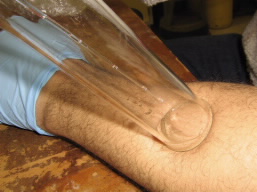FOR IMMEDIATE RELEASE | August 20, 2008
First detection of “odor profile” for skin cancer may lead to rapid, non-invasive diagnostic test
PHILADELPHIA, Aug. 20 2008 — Chemists today described the first identification of a specific “odor profile” for skin cancer, a discovery that could form the basis of a rapid, non-invasive test for diagnosing the most common type of cancer in the United States. The findings may enable doctors in the future to diagnose skin cancer quickly and accurately by waving a handheld scanner or sensor above the skin, they reported today at the 236th national meeting of the American Chemical Society.
Skin cancer is on the rise in this country, particularly among women under age 40. The new findings could lead to the development of diagnostic tools that could potentially save lives by detecting skin cancer before there are any outward signs, such as suspicious moles, the researchers say.
Contact
215-418-2407 (Philadelphia, Aug. 17-21)
202-872-4400 (Washington D.C.)
Diagnosing diseases on the basis of their characteristic odors is not new. For centuries, doctors relied on their sense of smell to identify signs of human illnesses. Sweet-smelling breath was a tell-tale sign of diabetes, while a foul-odor emitted by a wound indicated infection.
In the new study, Michelle Gallagher, Ph.D., and colleagues point out that scientists recently demonstrated that dogs can be trained to detect skin tumors because the tumors have a different smell than normal skin. Taking cues from this study, the researchers found that the skin of people with skin cancer releases a chemical odor profile very different from that of people without skin cancer.
“Researchers have speculated that tumors give off different odors, but we’re the first to identify and quantify the compounds involved in skin cancer odors,” says Gallagher, an analytical chemist who conducted the study while working as a post-doctoral researcher under George Preti, Ph.D., also a chemist, at the Monell Chemical Senses Center in Philadelphia.
“This research opens doors to potential new approaches to skin cancer diagnosis based on the profile of skin odors, hopefully leading to more rapid and non-invasive detection and diagnosis of this prevalent disease,” says Gallagher, now a chemist with Rohm and Haas in Spring House, Penn.
To examine whether skin odors change in people with skin cancer, Gallagher and colleagues used advanced chromatography techniques to sample and analyze the air above tumor sites in 11 patients diagnosed with basal cell carcinoma, the most common type of skin cancer with more than one million new cases every year. They compared the profile of chemicals detected above the tumor sites to profiles obtained from skin of 11 individuals without cancer.
“We found a different profile of chemicals above tumor sites relative to healthy skin,” says Gallagher. “The same chemicals are present, but at skin cancer sites some chemicals are increased, while others are decreased compared to healthy individuals.” She declined to give specific details about the chemicals found, noting that the researchers had applied for a patent on their technique.
The scientists eventually plan to identify a reliable “odor profile” of all three forms of skin cancer, including squamous cell cancer and melanoma, the deadliest form. If successful, the researchers hope to combine their method with emerging nano-sensor “electronic nose” technology designed to identify odorous chemicals. Gallagher envisions a wand-like “E-nose” that can be moved across the skin and will set off an alarm or beep when cancer is detected, similar to the fictional medical “tricorder” from Star Trek.
Skin cancer is currently diagnosed by conducting a biopsy of suspicious moles or lesions on the skin, which can be a slow and painful process. In cases where there are no physical signs of skin cancer, the disease can be extremely difficult to detect, leading to a delayed or missed diagnosis. Having a diagnostic method to detect skin cancer without any apparent signs would give doctors a head-start in fighting the disease, the researchers say. Funding for this study was provided, in-part, by the National Institutes of Health.
# # #
— Mark T. Sampson
Michelle Gallagher, Ph.D., is currently a Senior Scientist at Rohm and Haas in Philadelphia, Pennsylvania. She is formerly a chemist with Monell Chemical Senses Center in Philadelphia.
George Preti, Ph.D., is a chemist with Monell Chemical Senses Center in Philadelphia.


